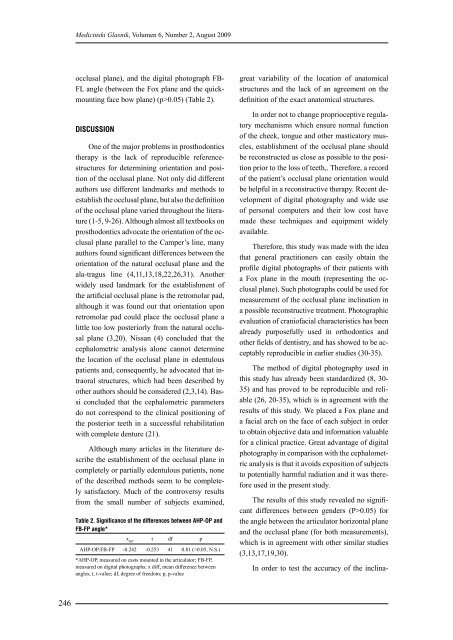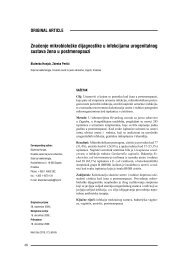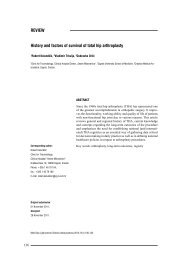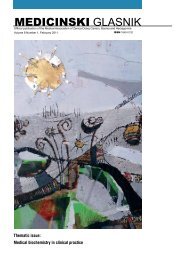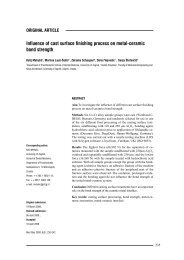MEDICINSKI GLASNIK
MEDICINSKI GLASNIK
MEDICINSKI GLASNIK
Create successful ePaper yourself
Turn your PDF publications into a flip-book with our unique Google optimized e-Paper software.
246<br />
Medicinski Glasnik, Volumen 6, Number 2, August 2009<br />
occlusal plane), and the digital photograph FB-<br />
FL angle (between the Fox plane and the quickmounting<br />
face bow plane) (p>0.05) (Table 2).<br />
DISCUSSION<br />
One of the major problems in prosthodontics<br />
therapy is the lack of reproducible referencestructures<br />
for determining orientation and position<br />
of the occlusal plane. Not only did different<br />
authors use different landmarks and methods to<br />
establish the occlusal plane, but also the definition<br />
of the occlusal plane varied throughout the literature<br />
(1-5, 9-26). Although almost all textbooks on<br />
prosthodontics advocate the orientation of the occlusal<br />
plane parallel to the Camper’s line, many<br />
authors found significant differences between the<br />
orientation of the natural occlusal plane and the<br />
ala-tragus line (4,11,13,18,22,26,31). Another<br />
widely used landmark for the establishment of<br />
the artificial occlusal plane is the retromolar pad,<br />
although it was found out that orientation upon<br />
retromolar pad could place the occlusal plane a<br />
little too low posteriorly from the natural occlusal<br />
plane (3,20). Nissan (4) concluded that the<br />
cephalometric analysis alone cannot determine<br />
the location of the occlusal plane in edentulous<br />
patients and, consequently, he advocated that intraoral<br />
structures, which had been described by<br />
other authors should be considered (2,3,14). Bassi<br />
concluded that the cephalometric parameters<br />
do not correspond to the clinical positioning of<br />
the posterior teeth in a successful rehabilitation<br />
with complete denture (21).<br />
Although many articles in the literature describe<br />
the establishment of the occlusal plane in<br />
completely or partially edentulous patients, none<br />
of the described methods seem to be completely<br />
satisfactory. Much of the controversy results<br />
from the small number of subjects examined,<br />
Table 2. Significance of the differences between AHP-OP and<br />
FB-FP angle*<br />
x diff t df p<br />
AHP-OP:FB-FP -0.242 -0.253 41 0.81 (>0.05, N.S.)<br />
*AHP-OP, measured on casts mounted in the articulator; FB-FP,<br />
measured on digital photographs; x diff, mean difference between<br />
angles; t, t-value; df, degree of freedom; p, p-value<br />
great variability of the location of anatomical<br />
structures and the lack of an agreement on the<br />
definition of the exact anatomical structures.<br />
In order not to change proprioceptive regulatory<br />
mechanisms which ensure normal function<br />
of the cheek, tongue and other masticatory muscles,<br />
establishment of the occlusal plane should<br />
be reconstructed as close as possible to the position<br />
prior to the loss of teeth,. Therefore, a record<br />
of the patient’s occlusal plane orientation would<br />
be helpful in a reconstructive therapy. Recent development<br />
of digital photography and wide use<br />
of personal computers and their low cost have<br />
made these techniques and equipment widely<br />
available.<br />
Therefore, this study was made with the idea<br />
that general practitioners can easily obtain the<br />
profile digital photographs of their patients with<br />
a Fox plane in the mouth (representing the occlusal<br />
plane). Such photographs could be used for<br />
measurement of the occlusal plane inclination in<br />
a possible reconstructive treatment. Photographic<br />
evaluation of craniofacial characteristics has been<br />
already purposefully used in orthodontics and<br />
other fields of dentistry, and has showed to be acceptably<br />
reproducible in earlier studies (30-35).<br />
The method of digital photography used in<br />
this study has already been standardized (8, 30-<br />
35) and has proved to be reproducible and reliable<br />
(26, 20-35), which is in agreement with the<br />
results of this study. We placed a Fox plane and<br />
a facial arch on the face of each subject in order<br />
to obtain objective data and information valuable<br />
for a clinical practice. Great advantage of digital<br />
photography in comparison with the cephalometric<br />
analysis is that it avoids exposition of subjects<br />
to potentially harmful radiation and it was therefore<br />
used in the present study.<br />
The results of this study revealed no significant<br />
differences between genders (P>0.05) for<br />
the angle between the articulator horizontal plane<br />
and the occlusal plane (for both measurements),<br />
which is in agreement with other similar studies<br />
(3,13,17,19,30).<br />
In order to test the accuracy of the inclina


